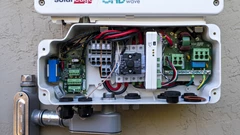EV Credit, Methane Fees: What $555 Billion Climate Plan Would Do
(Bloomberg) -- The spending bill House Democrats passed Friday and sent to the Senate calls for the largest-ever investment in fighting climate change: $555 billion on clean power, electric vehicles and resilience to global warming.
The White House has said the bill, which faces an uncertain fate in the Senate, sets the U.S. on a course to meet ambitious climate goals that include a 50% to 52% reduction in greenhouse gas emissions below 2005 levels by 2030 and a 100% carbon pollution-free power sector by 2035.
It would slap a first-time fee on the emission of methane -- a potent greenhouse gas -- from the oil and gas sector, while barring oil drilling in most U.S. waters and Alaska’s Arctic National Wildlife Refuge.
While mainstream environmental groups have cheered the bill, it’s been blasted by activists for failing to repeal oil industry tax breaks and for providing billions in subsidies that would prolong the life of coal-fired power plants through carbon-capture projects. A plan to compel utilities to generate electricity using clean power sources, and to fine those that don’t, was dropped after opposition from West Virginia Senator Joe Manchin, a key Democratic swing vote in the evenly-split Senate.
“The Build Back Better Act will be the largest investment ever in climate action, natural resource restoration, community resilience and revitalization, clean water and air, and good-paying jobs since the New Deal,” said Collin O’Mara, president and CEO of the National Wildlife Federation.
Republicans criticized the legislation as “socialist,” saying it would lead to higher electricity bills and provide tax breaks for millionaires.
Here’s a look at what’s in the bill:
Tax credits to spur clean energy investment
By far the largest component of the climate spending -- some $300 billion -- would go to expanding tax credits for renewable power, biofuels and energy efficiency. The credits could accelerate clean-energy investments at both the utility and residential levels, as well as in electric transmission, power storage and manufacturing.
Included are an increase in tax credits for utilities and other facilities that employ carbon capture technologies, and new tax credits for energy storage, transmission projects, hydrogen production, and electricity from existing nuclear reactors that could provide a lifeline to struggling plants.
Biofuel credits would be extended and new credits created for sustainable aviation fuel. A popular credit dating back to the Obama administration would be reinstated for manufacturers of wind turbines, solar panels, fuel cells and other clean-energy equipment.
In a twist, after five years, energy tax credits would get whittled down into just a handful for electricity and transportation that would be doled out on a sliding scale based on emissions reductions. That could present transitional risks to recipients.
Electric vehicle incentives to boost sales, union jobs
Detroit automakers would be able to offer $4,500 more in tax credits to U.S. electric-car buyers, to as much as $12,500 for vehicles that are manufactured in America with union labor.
Under the bill, a $7,500 consumer tax credit would be made refundable and would be boosted by $4,500 more for cars assembled domestically by plants represented by unions. An additional $500 bonus would be added for vehicles that use U.S.-made batteries.
A new perk in the legislation creates a $4,000 tax credit for the purchase of used EVs.
Hundreds of millions dollars would also go toward installation of EV charging systems and $3.5 billion to the Energy Department for grants for the domestic production of electric and hydrogen fuel vehicles. The General Services Administration would get $3 billion for the procurement of EVs for government fleets. And the U.S. Postal Service would get nearly $6 billion for the purchase of electric mail trucks and charging infrastructure, a move traders have seen as positive for Loveland, Ohio-based electric vehicle manufacturer Workhorse Group Inc.
A separate infrastructure bill, signed into law this week by President Joe Biden, would dole out $7.5 billion for EV chargers.
Oil drilling banned in Alaska’s ANWR, new offshore sites
The Democrats’ spending package would block oil drilling in Alaska’s Arctic National Wildlife Refuge and new offshore drilling in most U.S. waters.
The legislation would bar the sale of new oil and gas leases in Pacific and Atlantic waters as well as the eastern Gulf of Mexico. It also would abolish a four-year-old requirement that the government sell drilling rights in the Arctic refuge’s coastal plain while voiding nine leases issued in that northeast Alaska region earlier this year.
Leasing would still be conducted in the central and western Gulf.
The oil and gas industry criticized the House-passed legislation. Its oil and gas provisions “are nothing more than punitive measures,” said National Ocean Industries Association President Erik Milito.
“These include arbitrary new fees that would add millions of dollars in annual operating costs, pricing out U.S. production,” he said.
Methane release fees imposed on oil, gas companies
The package would force oil and gas companies to pay for excess methane leaking from wells, storage sites and pipelines for the first time. Fees of as much as $1,500 a ton would be imposed on an array of oil and gas infrastructure on the emission of methane, which pound for pound has more than 80 times the heat-trapping power of carbon dioxide and is blamed for a quarter of global warming.
The provision could be watered down or stricken in the Senate, however.
The legislation would also impose new fees on the oil and gas industry including a $4 per acre, per year “Conservation of Resources Fee” for all new producing onshore and offshore oil and gas leases and a $6 per acre, per year “Speculative Leasing Fee” for all new non-producing onshore and offshore oil and gas leases.
It would also create annual fees of as much as $10,000 per mile on offshore pipelines and raise the royalty rates for all new oil and gas leases.
Funding to create Civilian Climate Corps
The legislation would provide billions of dollars to create a Civilian Climate Corps that could put hundreds of thousands of Americans to work preventing wildfires, restoring wetlands, capping abandoned oil wells and making homes more energy-efficient.
The program, which would be modeled after the New Deal-era Civilian Conservation Corps, has high-level champions who see it as both an economic development and environmental plan.
More stories like this are available on bloomberg.com
©2021 Bloomberg L.P.
KEEPING THE ENERGY INDUSTRY CONNECTED
Subscribe to our newsletter and get the best of Energy Connects directly to your inbox each week.
By subscribing, you agree to the processing of your personal data by dmg events as described in the Privacy Policy.
More renewables news

GB Energy Faces Doubts as UK Declines to Affirm Future Funds

Korea Cancels Planned Reactor After Impeaching Pro-Nuke Leader

Brazil’s Net-Zero Transition Will Cost $6 Trillion by 2050, BNEF Says

SolarEdge Climbs 40% as Revenue Beat Prompts Short Covering

EU to Set Aside Funds to Protect Undersea Cables from Sabotage

China Revamps Power Market Rules In Challenge to Renewables Boom

KKR increases stake in Enilive with additional €587.5 million investment

TotalEnergies and Air Liquide partner to develop green hydrogen projects in the Netherlands

Germany Set to Scale Down Climate Ambitions
















